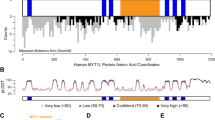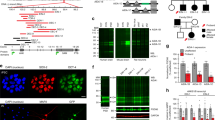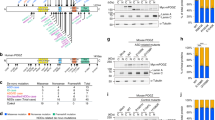Abstract
Rett syndrome (RTT) is unique among genetic, chromosomal and other developmental disorders because of its extreme female gender bias, early normal development, and subsequent developmental regression with loss of motor and language skills. RTT is caused by heterozygosity for mutations in the X-linked gene MECP2, which encodes methyl-CpG binding protein 2. MeCP2 is a multifunctional protein that can act as an architectural chromatin-binding protein, a function that is unrelated to its ability to bind methyl-CpG and to attract chromatin modification complexes. Inactivating mutations that cause RTT in females are not prenatally lethal in males, but lead to profound congenital encephalopathy. Molecular diagnoses of RTT, through demonstration of a MECP2 mutation, made at an early stage of the disorder, usually confirm the sporadic nature and very low recurrence risk of the condition. A positive DNA test result, however, also predicts the inevitable clinical course, given the lack of effective intervention. Initial hypotheses indicating that the MeCP2 protein acts as a genome-wide transcriptional repressor were not confirmed by global gene expression studies in various tissues of individuals with RTT and mouse models of MeCP2 deficiency. Rather, recent evidence points to low-magnitude effects of a small number of genes—including the brain-derived neurotrophic factor pathway and glucocorticoid response genes—that might affect formation and maturation of synapses or synaptic function in postmitotic neurons.
Key Points
-
Rett syndrome (RTT) in females is caused by heterozygous de novo mutations in the MECP2 (methyl-CpG binding protein 2) gene
-
Null mutations in MECP2 that cause classic RTT in females are not prenatally lethal in boys, but cause a distinct form of congenital encephalopathy
-
Functional genetic studies in mouse models of MeCP2 deficiency identified postmitotic neurons as the site for pathogenetic mechanisms, and highlighted the need for tight control of MeCP2 levels in the brain
-
MeCP2 can act as an architectural chromatin binding protein, a function that is unrelated to its ability to bind methyl-CpG and attract chromatin modification complexes
-
Although differential CpG methylation patterns are essential for epigenetic regulation of gene expression, there is no confirmed evidence that loss of MeCP2 function leads to epigenetic dysregulation in vivo in any of the systems studied
-
Brain-derived neurotrophic factor (BDNF), a direct MeCP2 target, is able to modulate onset and disease progression in Mecp2 mutant mice, indicating potential therapeutic opportunities
This is a preview of subscription content, access via your institution
Access options
Subscribe to this journal
Receive 12 print issues and online access
$209.00 per year
only $17.42 per issue
Buy this article
- Purchase on Springer Link
- Instant access to full article PDF
Prices may be subject to local taxes which are calculated during checkout


Similar content being viewed by others
References
Rett A (1966) Uber ein eigenartiges hirnatrophisches Syndrom bei Hyperammonamie im Kindesalter. Wien Med Wochenschr 116: 723–738
Einspieler C et al. (2005) Abnormal general movements in girls with Rett disorder: the first four months of life. Brain Dev 27 (Suppl 1): S8–S13
Schanen NC et al. (1997) A new Rett syndrome family consistent with X-linked inheritance expands the X chromosome exclusion map. Am J Hum Genet 61: 634–641
Schanen NC and Francke U (1998) A severely affected male born into a Rett syndrome kindred supports X-linked inheritance and allows extension of the exclusion map. Am J Hum Genet 63: 267–269
Sirianni N et al. (1998) Rett syndrome: confirmation of X-linked dominant inheritance, and localization of the gene to Xq28. Am J Hum Genet 63: 1552–1558
Amir RE et al. (1999) Rett syndrome is caused by mutations in X-linked MECP2, encoding methyl-CpG-binding protein 2. Nat Genet 23: 185–188
Wan M et al. (1999) Rett syndrome and beyond: recurrent spontaneous and familial MECP2 mutations at CpG hotpots. Am J Hum Genet 65: 1520–1529
Ravn K et al. (2005) Large genomic rearrangements in MECP2. Hum Mutat 25: 324
Mnatzakanian GN et al. (2004) A previously unidentified MECP2 open reading frame defines a new protein isoform relevant to Rett syndrome. Nat Genet 36: 339–341
Kriaucionis S and Bird A (2004) The major form of MeCP2 has a novel N-terminus generated by alternative splicing. Nucleic Acids Res 32: 1818–1823
Amir RE et al. (2005) Mutations in exon 1 of MECP2 are a rare cause of Rett syndrome. J Med Genet 42: e15
Hoffbuhr K et al. (2001) MeCP2 mutations in children with and without the phenotype of Rett syndrome. Neurology 56: 1486–1495
Weaving LS et al. (2003) Effects of MECP2 mutation type, location and X-inactivation in modulating Rett syndrome phenotype. Am J Med Genet A 118: 103–114
Huppke P et al. (2002) Influence of mutation type and location on phenotype in 123 patients with Rett Syndrome. Neuropediatrics 33: 63–68
Colvin L et al. (2004) Refining the phenotype of common mutations in Rett syndrome. J Med Genet 41: 25–30
Smeets E et al. (2005) Rett syndrome in females with CTS hot spot deletions: a disorder profile. Am J Med Genet A 132: 117–120
Shibayama A et al. (2004) MECP2 structural and 3'-UTR variants in schizophrenia, autism and other psychiatric diseases: a possible association with autism. Am J Med Genet B Neuropsychiatr Genet 128: 50–53
Imessaoudene B et al. (2001) MECP2 mutation in non-fatal, non-progressive encephalopathy in a male. J Med Genet 38: 171–174
Hitchins MP et al. (2004) Investigation of UBE3A and MECP2 in Angelman syndrome (AS) and patients with features of AS. Am J Med Genet A 125: 167–172
Kleefstra T et al. (2004) MECP2 analysis in mentally retarded patients: implications for routine DNA diagnostics. Eur J Hum Genet 12: 24–28
Maiwald R et al. (2002) De novo MECP2 mutation in a 46,XX male patient with Rett syndrome. Neurogenetics 4: 107–108
Clayton-Smith J et al. (2000) Somatic mutation in MECP2 as a non-fatal neurodevelopmental disorder in males. Lancet 356: 830–832
Topcu M et al. (2002) Somatic mosaicism for a MECP2 mutation associated with classic Rett syndrome in a boy. Eur J Hum Genet 10: 77–81
Villard L et al. (2000) Two affected boys in a Rett syndrome family: clinical and molecular findings. Neurology 55: 1188–1193
Zeev BB et al. (2002) Rett syndrome: clinical manifestations in males with MECP2 mutations. J Child Neurol 17: 20–24
Lynch SA et al. (2003) Sporadic case of fatal encephalopathy with neonatal onset associated with a T158M missense mutation in MECP2. Arch Dis Child Fetal Neonatal Ed 88: F250–252
Leuzzi V et al. (2004) Early-onset encephalopathy and cortical myoclonus in a boy with MECP2 gene mutation. Neurology 63: 1968–1970
Meloni I et al. (2000) A mutation in the Rett syndrome gene, MECP2, causes X-linked mental retardation and progressive spasticity in males. Am J Hum Genet 67: 982–985
Yntema HG et al. (2002) Low frequency of MECP2 mutations in mentally retarded males. Eur J Hum Genet 10: 487–490
Ylisaukko-Oja T et al. (2005) MECP2 mutation analysis in patients with mental retardation. Am J Med Genet A 132: 121–124
Van Esch H et al. (2005) Duplication of the MECP2 region is a frequent cause of severe mental retardation and progressive neurological symptoms in males. Am J Hum Genet 77: 442–453
Evans JC et al. (2005) Early onset seizures and Rett-like features associated with mutations in CDKL5. Eur J Hum Genet 13: 1113–1120
Tate P et al. (1996) The methyl-CpG binding protein MeCP2 is essential for embryonic development in the mouse. Nature Genet 12: 205–208
Chen RZ et al. (2001) Deficiency of methyl-CpG binding protein-2 in CNS neurons results in a Rett-like phenotype in mice. Nat Genet 27: 327–331
Guy J et al. (2001) A mouse Mecp2-null mutation causes neurological symptoms that mimic Rett syndrome. Nat Genet 27: 322–326
Shahbazian M et al. (2002) Mice with truncated MeCP2 recapitulate many Rett syndrome features and display hyperacetylation of histone H3. Neuron 35: 243–254
Luikenhuis S et al. (2004) Expression of MeCP2 in postmitotic neurons rescues Rett syndrome in mice. Proc Natl Acad Sci USA 101: 6033–6038
Collins AL et al. (2004) Mild overexpression of MeCP2 causes a progressive neurological disorder in mice. Hum Mol Genet 13: 2679–2689
Traynor J et al. (2002) Gene expression patterns vary in clonal cell cultures from Rett syndrome females with eight different MECP2 mutations. BMC Med Genet 3: 12
Ronnett GV et al. (2003) Olfactory biopsies demonstrate a defect in neuronal development in Rett's syndrome. Ann Neurol 54: 206–218
Shahbazian MD et al. (2002) Insight into Rett syndrome: MeCP2 levels display tissue- and cell-specific differences and correlate with neuronal maturation. Hum Mol Genet 11: 115–124
Jung BP et al. (2003) The expression of methyl CpG binding factor MeCP2 correlates with cellular differentiation in the developing rat brain and in cultured cells. J Neurobiol 55: 86–96
Nagai K et al. (2005) A transcriptional repressor MeCP2 causing Rett syndrome is expressed in embryonic non-neuronal cells and controls their growth. Brain Res Dev Brain Res 157: 103–106
Kishi N and Macklis JD (2004) MECP2 is progressively expressed in post-migratory neurons and is involved in neuronal maturation rather than cell fate decisions. Mol Cell Neurosci 27: 306–321
Matarazzo V et al. (2004) The transcriptional repressor Mecp2 regulates terminal neuronal differentiation. Mol Cell Neurosci 27: 44–58
Lewis JD et al. (1992) Purification, sequence, and cellular localization of a novel chromosomal protein that binds to methylated DNA. Cell 69: 905–914
Nan X et al. (1997) MeCP2 is a transcriptional repressor with abundant binding sites in genomic chromatin. Cell 88: 471–481
Kokura K et al. (2001) The Ski protein family is required for MeCP2-mediated transcriptional repression. J Biol Chem 276: 34115–34121
Harikrishnan KN et al. (2005) Brahma links the SWI/SNF chromatin-remodeling complex with MeCP2-dependent transcriptional silencing. Nat Genet 37: 254–264
Klose RJ and Bird AP (2004) MeCP2 behaves as an elongated monomer that does not stably associate with the Sin3a chromatin remodeling complex. J Biol Chem 279: 46490–46496
Fuks F et al. (2003) The DNA methyltransferases associate with HP1 and the SUV39H1 histone methyltransferase. Nucleic Acids Res 31: 2305–2312
Kimura H and Shiota K (2003) Methyl-CpG-binding protein, MeCP2, is a target molecule for maintenance DNA methyltransferase, Dnmt1. J Biol Chem 278: 4806–4812
Jeffery L and Nakielny S (2004) Components of the DNA methylation system of chromatin control are RNA-binding proteins. J Biol Chem 279: 49479–49487
Buschdorf JP and Stratling WH (2004) A WW domain binding region in methyl-CpG-binding protein MeCP2: impact on Rett syndrome. J Mol Med 82: 135–143
Young JI et al. (2005) Regulation of RNA splicing by the methylation-dependent transcriptional repressor methyl-CpG binding protein 2. Proc Natl Acad Sci USA 102: 17551–17558
von Kries JP et al. (1991) A matrix/scaffold attachment region binding protein: identification, purification, and mode of binding. Cell 64: 123–135
Chandler SP et al. (1999) The methyl-CpG binding transcriptional repressor MeCP2 stably associates with nucleosomal DNA. Biochemistry 38: 7008–7018
Georgel PT et al. (2003) Chromatin compaction by human MeCP2: assembly of novel secondary chromatin structures in the absence of DNA methylation. J Biol Chem 278: 32181–32188
Horike S et al. (2005) Loss of silent-chromatin looping and impaired imprinting of DLX5 in Rett syndrome. Nat Genet 37: 31–40
Razin A and Shemer R (1999) Epigenetic control of gene expression. Results Probl Cell Differ 25: 189–204
Balmer D et al. (2002) MECP2 mutations in Rett syndrome adversely affect lymphocyte growth, but do not affect imprinted gene expression in blood or brain. Hum Genet 110: 545–552
Kimura MI et al. (2004) Dlx5, the mouse homologue of the human-imprinted DLX5 gene, is biallelically expressed in the mouse brain. J Hum Genet 49: 273–277
Samaco RC et al. (2005) Epigenetic overlap in autism-spectrum neurodevelopmental disorders: MECP2 deficiency causes reduced expression of UBE3A and GABRB3. Hum Mol Genet 14: 483–492
Makedonski K et al. (2005) MeCP2 deficiency in Rett syndrome causes epigenetic aberrations at the PWS/AS imprinting center that affects UBE3A expression. Hum Mol Genet 14: 1049–1058
Gartler SM et al. (2004) Normal histone modifications on the inactive X chromosome in ICF and Rett syndrome cells: implications for methyl-CpG binding proteins. BMC Biol 2: 21
Colantuoni C et al. (2001) Gene expression profiling in postmortem Rett syndrome brain: differential gene expression and patient classification. Neurobiol Dis 8: 847–865
Tudor M et al. (2002) Transcriptional profiling of a mouse model for Rett syndrome reveals subtle transcriptional changes in the brain. Proc Natl Acad Sci USA 99: 15536–15541
Ballestar E et al. (2005) The impact of MECP2 mutations in the expression patterns of Rett syndrome patients. Hum Genet 116: 91–104
Stancheva I et al. (2003) A mutant form of MeCP2 protein associated with human Rett syndrome cannot be displaced from methylated DNA by notch in Xenopus embryos. Mol Cell 12: 425–435
Chen WG et al. (2003) Derepression of BDNF transcription involves calcium-dependent phosphorylation of MeCP2. Science 302: 885–889
Martinowich K et al. (2003) DNA methylation-related chromatin remodeling in activity-dependent BDNF gene regulation. Science 302: 890–893
Chang Q et al. (2006) The disease progression of Mecp2 mutant mice is affected by the level of BDNF expression. Neuron 49: 341–348
Gorski JA et al. (2003) Brain-derived neurotrophic factor is required for the maintenance of cortical dendrites. J Neurosci 23: 6856–6865
Salama-Cohen P et al. (2005) NGF controls dendrite development in hippocampal neurons by binding to p75NTR and modulating the cellular targets of Notch. Mol Biol Cell 16: 339–347
Armstrong DD (1995) The neuropathology of Rett syndrome—overview 1994. Neuropediatrics 26: 100–104
Belichenko PV et al. (2005) Dendritic alterations in the brains of mouse models of Rett syndrome. In Proceedings of the RSRF 6th Annual Rett Syndrome Symposium, 2005 June 27–29; Itasca, IL
Nuber UA et al. (2005) Up-regulation of glucocorticoid-regulated genes in a mouse model of Rett syndrome. Hum Mol Genet 14: 2247–2256
Acknowledgements
The author thanks Hong-Hua Li, ChaRandle Jordan, Birgitt Schüle and Pavel Belichenko for helpful discussions, Rick Cuevas for assistance with the manuscript, and the March of Dimes Birth Defects Foundation and the International Rett Syndrome Association for financial support.
Author information
Authors and Affiliations
Corresponding author
Ethics declarations
Competing interests
The author declares no competing financial interests.
Rights and permissions
About this article
Cite this article
Francke, U. Mechanisms of Disease: neurogenetics of MeCP2 deficiency. Nat Rev Neurol 2, 212–221 (2006). https://doi.org/10.1038/ncpneuro0148
Received:
Accepted:
Issue Date:
DOI: https://doi.org/10.1038/ncpneuro0148
This article is cited by
-
Molecular Testing of MECP2 Gene in Rett Syndrome Phenotypes in Indian Girls
Indian Pediatrics (2018)
-
Rett syndrome – biological pathways leading from MECP2 to disorder phenotypes
Orphanet Journal of Rare Diseases (2016)
-
Molecular underpinnings of prefrontal cortex development in rodents provide insights into the etiology of neurodevelopmental disorders
Molecular Psychiatry (2015)
-
CDKL5 ensures excitatory synapse stability by reinforcing NGL-1–PSD95 interaction in the postsynaptic compartment and is impaired in patient iPSC-derived neurons
Nature Cell Biology (2012)
-
Up-Regulated Methyl CpG Binding Protein-2 in Intractable Temporal Lobe Epilepsy Patients and a Rat Model
Neurochemical Research (2012)



